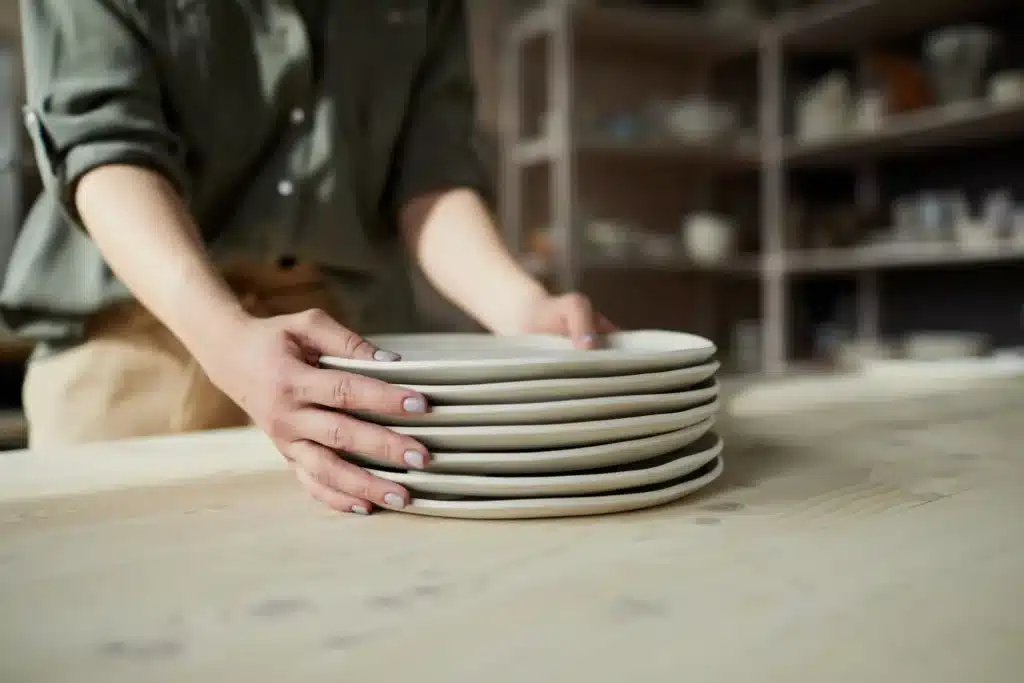What is the best way to pack plates for moving so you give them the best chance of arriving at your new home in the condition they left the old one? Plates are the square peg in a round hole of packing, or rather the round items you need to fit into square boxes. They’re also usually breakable and come in sets. So let’s look at the best way to pack plates so they have the best protection while getting carried and transported.
-
Packing materials required
- Use medium-sized boxes for packing plates. We recommend using packing boxes, as they are designed to protect breakables.
- Large sheets of clean packing paper, bubble wrap and space fillers like packing peanuts.
- Packing tape and a permanent marker.
-
Assemble your boxes
- If your boxes are new, assemble them into shape and place them on a flat surface with the bottom side up.
- It’s important to give your boxes strength with packing tape. Seal the centre seam of the box starting from a third of the way up on one side, over the centre seam, and up the other side with one strip of tape. Repeat with the strip of tape slightly offset from the first.
- Test the box’s strength by gently pushing against the seam from inside the box. If there is still some give in the seam, turn it over and tape it again. Repeat this step as many times as necessary until it feels solid.
- Seal the side seams at the bottom of the box, again with one continuous strip of tape.
- Now that you have assembled your box, turn it over.
- Create a soft bed at the bottom of the box. You can use bubble wrap, balls of paper, towels and even cushions that suit the size of the box. Now, you’re set to pack your plates.
-
Wrapping plates
- The key to avoiding damage to plates is to wrap them individually. Ceramics are hard, so they become abrasive when rubbed together. You may not have breakages if you wrap plates in bundles, but you are more likely to get scratches and unsightly marks.
- Start by laying your packing paper out on a flat surface like a table or bench.
- Large plates: Position the plate at the centre of the paper and fold the corners to the middle. Set your first plate aside and wrap the next one. Stack them up, one by one, in piles of the same size. Once you have a set ready to pack, secure the stack with packing tape so it becomes one solid unit.
- Small plates and bowls: position your plate or bowl at the centre of the packing paper and fold one corner over to cover it. Place the second plate onto the first and fold another corner over. Repeat until you have wrapped four plates into one bundle, then secure it with packing tape into one solid unit.
-
Filling your assembled boxes
Our instinct is to pack plates flat in a box, the same way we use them at the table, but this is actually more likely to cause breakages. Plates can take more pressure when you pack them standing on their side in the box.
Get your wrapped stacks and fit them into the box on their side so they sit snugly together with as few gaps as possible. Use your space fillers to plug the gaps so there is no chance for the stacks to move about and knock into each other.
Put another layer of soft cushioning on the top, the same way as you protected the base of the box. Fold the top flaps and seal the centre and open seams with packing tape. Again, use more than one strip of tape for strength.
-
Label your boxes
It’s important to mark every box with the contents, and even more so with breakables if you aren’t carrying them yourself.
We recommend you label your boxes of plates with the following:
- FRAGILE
- Kitchen
- Plates
We hope you have found this guide useful, and we’ll be posting more detailed packing guides in the coming months. Always remember, if you aren’t confident about packing yourself, we can do it for you, and it won’t cost as much as you would expect. Give us a call if you need a packing quote.
